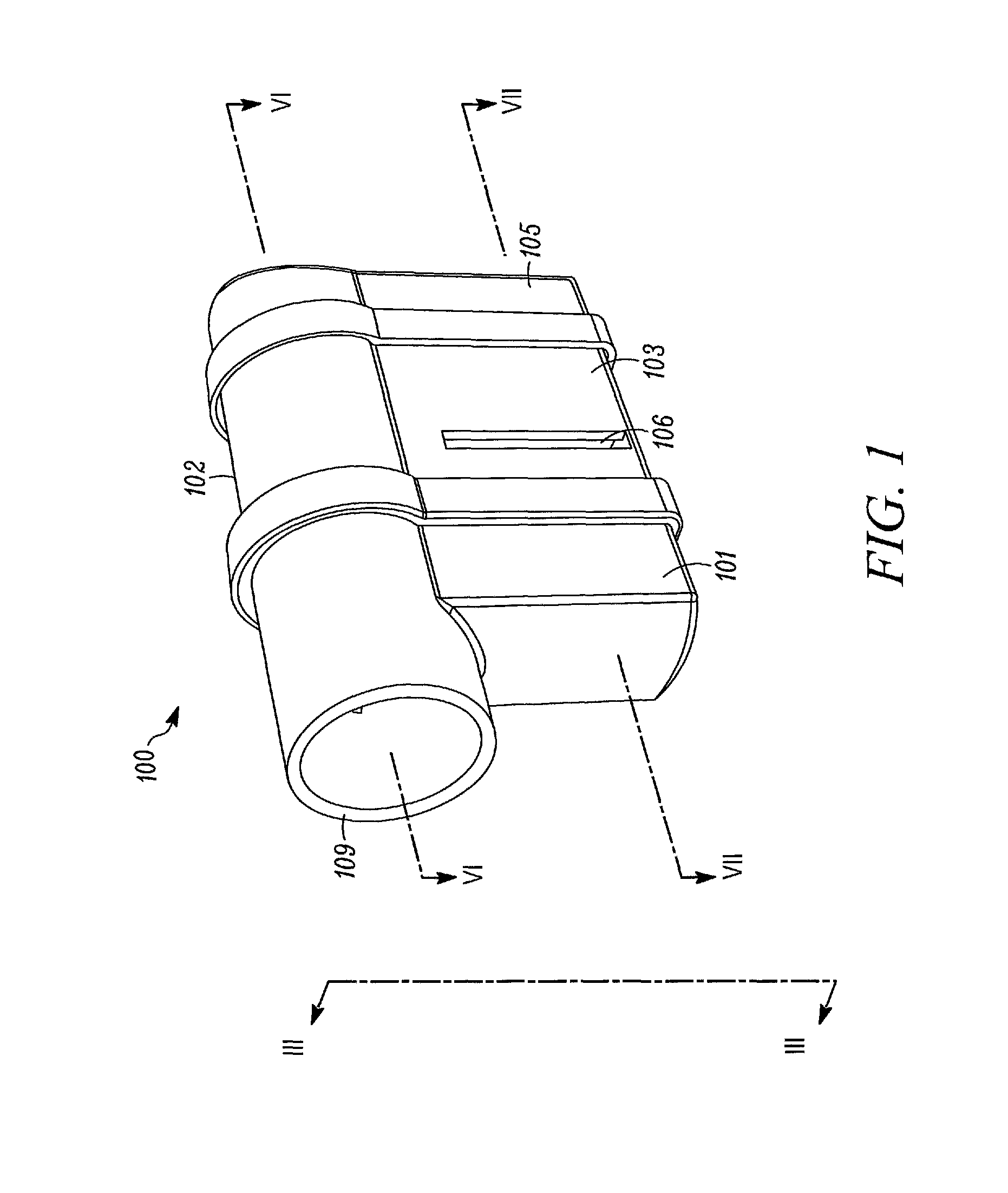Oscillating Positive Expiratory Pressure Device
a positive expiratory pressure and oscillating technology, applied in the direction of inhalators, life-saving devices, gymnastic exercise, etc., can solve the problems of affecting the bronchial obstruction, splitting open obstructed airways, and insufficient single cough to clear obstructions
- Summary
- Abstract
- Description
- Claims
- Application Information
AI Technical Summary
Benefits of technology
Problems solved by technology
Method used
Image
Examples
first embodiment
[0106]Referring first to FIGS. 1-4, a front perspective view, a rear perspective view, a cross-sectional front perspective view, and an exploded view of an OPEP device 100 are shown. For purposes of illustration, the internal components of the OPEP device 100 are omitted in FIG. 3. The OPEP device 100 generally comprises a housing 102, a chamber inlet 104, a first chamber outlet 106, a second chamber outlet 108 (best seen in FIGS. 2 and 7), and a mouthpiece 109 in fluid communication with the chamber inlet 104. While the mouthpiece 109 is shown in FIGS. 1-4 as being integrally formed with the housing 102, it is envisioned that the mouthpiece 109 may be removable and replaceable with a mouthpiece 109 of a different size or shape, as required to maintain ideal operating conditions. In general, the housing 102 and the mouthpiece 109 may be constructed of any durable material, such as a polymer. One such material is Polypropylene. Alternatively, acrylonitrile butadiene styrene (ABS) may...
second embodiment
[0133]Turning now to FIGS. 18-19, a front perspective view and a rear perspective view of a second embodiment of an OPEP device 200 is shown. The configuration and operation of the OPEP device 200 is similar to that of the OPEP device 100. However, as best shown in FIGS. 20-24, the OPEP device 200 further includes an adjustment mechanism 253 adapted to change the relative position of the chamber inlet 204 with respect to the housing 202 and the restrictor member 230, which in turn changes the range of rotation of the vane 232 operatively connected thereto. As explained below, a user is therefore able to conveniently adjust both the frequency and the amplitude of the OPEP therapy administered by the OPEP device 200 without opening the housing 202 and disassembling the components of the OPEP device 200.
[0134]The OPEP device 200 generally comprises a housing 202, a chamber inlet 204, a first chamber outlet 206 (best seen in FIGS. 23 and 32), a second chamber outlet 208 (best seen in FI...
third embodiment
[0149]Turning now to FIGS. 35-38, a third embodiment of an OPEP device 300 is shown. As described below, with the exception of an adjustment mechanism 353, the design and operation of the OPEP device 300 is the same as the OPEP device 200. For example, as seen in the front perspective view of FIG. 35, a housing 302 of the OPEP device 300 includes a mouthpiece 309, a first chamber outlet 306, and a second chamber outlet (not shown) positioned opposite the first chamber outlet 306. The housing 302 is formed of a front section 301, a middle section 303, and a rear section 305. As shown in the cross-sectional view of FIG. 36, the OPEP device 300 also includes a restrictor member 330 operatively connected to a vane 332 by a shaft (not shown), and a variable nozzle 336 separating a first chamber 314 and a second chamber 318. Finally, an exhalation flow path 310, identified by a dashed line, is formed between the mouthpiece 309 and at least one of the first chamber outlet 306 and the secon...
PUM
 Login to View More
Login to View More Abstract
Description
Claims
Application Information
 Login to View More
Login to View More - R&D
- Intellectual Property
- Life Sciences
- Materials
- Tech Scout
- Unparalleled Data Quality
- Higher Quality Content
- 60% Fewer Hallucinations
Browse by: Latest US Patents, China's latest patents, Technical Efficacy Thesaurus, Application Domain, Technology Topic, Popular Technical Reports.
© 2025 PatSnap. All rights reserved.Legal|Privacy policy|Modern Slavery Act Transparency Statement|Sitemap|About US| Contact US: help@patsnap.com



